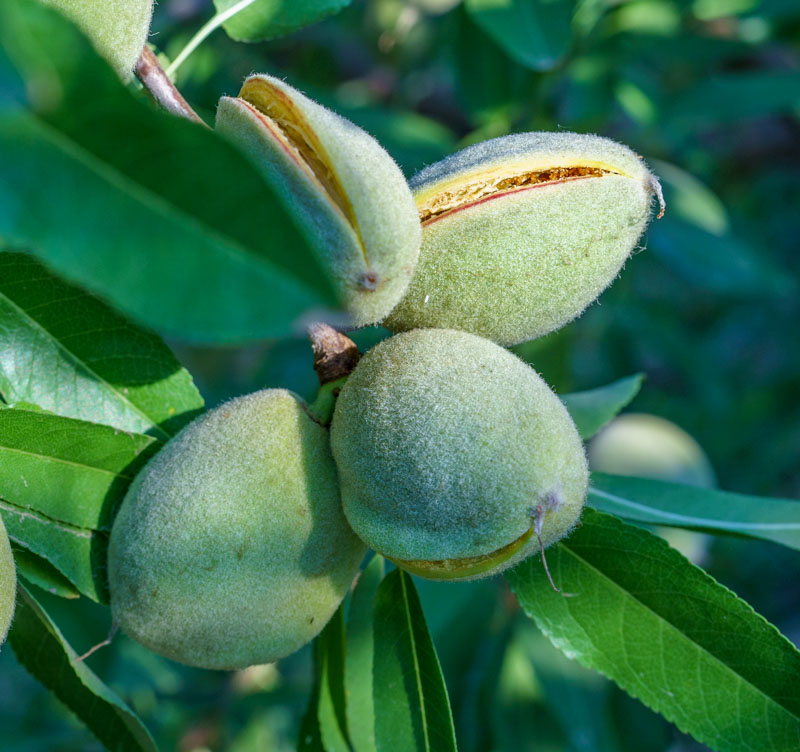Almond hull split is a critical stage in crop development. Hull split is when the outer layer of the almond, called the hull, opens to reveal the shell and the kernel inside. This happens as the nut ripens and dries. Hall split timing can vary depending on weather conditions and variety.
Hull split is important for two reasons:
- It signals the proper timing for treatments to control pests and diseases
- And it impacts the quality and yield of your harvest
What is Almond Hull Split?
Hull split is the natural process of almond nut development. As the kernel grows and fills the shell, it pushes against the hull, causing it to split along the suture line.
Almond hull splitting usually occurs from mid-June to mid-August, depending on the variety and the weather. For instance, the variety Nonpareil typically splits in early to mid-July, earlier than some other varieties.
Hull split can be classified into three stages:
- Initial hull split: This is when the hull begins to open at the tip of the fruit, forming a deep “V” shape. This stage usually overlaps with the initiation of the second flight of Navel Orangeworm (NOW), a major pest of almonds.
- Full hull split: This is when the entire suture opens, exposing the shell and the kernel. This stage is optimal for treatments to control pests and hull rot, a fungal disease that affects almond hulls.
- Complete hull split: This is when the hull separates from the shell and falls off, leaving only the shelled nut attached to the tree. This stage indicates that the nuts are ready for harvest.
How to Monitor Hull Split?
Monitoring hull split is essential for determining the best time to spray for NOW and hull rot. The most reliable way to monitor hull split is to inspect your trees from the top down, starting in the southwest corner of the canopy. The southwest quadrant of the orchard block is where the nuts mature faster due to exposure to hot afternoon sun.
To determine if hull split has occurred, you can squeeze the end of the hull and see if it opens completely. If it does, then you have reached full hull split and it’s time to spray. Hull split applications should be made no later than at 1% hull split.
Navel Orangeworm (NOW)
NOW is a major pest of almonds that can cause considerable damage and reduce crop quality. NOW larvae feed on almond kernels, leaving behind frass (excrement) and webbing that can contaminate nuts and increase aflatoxin levels. Aflatoxin is a carcinogenic toxin produced by certain fungi that can grow on nuts.
NOW adults are moths that lay eggs on almond hulls during hull split. The eggs hatch into larvae that bore into the nuts and feed on the kernels. The larvae can also move from one nut to another, spreading damage throughout the orchard.
To control NOW, growers should apply insecticides at full hull split, when most nuts are susceptible to egg-laying. The insecticides should target both eggs & larvae and have a long residual activity to provide protection until harvest. Growers should also practice good orchard sanitation. Sanitation is a process of removing mummy nuts (those that remain on trees after harvest) during winter, as they can harbor overwintering NOW populations.
Hull Rot
Hull rot is a fungal disease that affects almond hulls during hull split. It can cause premature defoliation, reduce nut quality, and lower yields. And can also increase water stress and susceptibility to other diseases.
Rot is caused by three different fungi: Rhizopus Stolonifer, Aspergillus Niger, and Monilinia Laxa. These fungi enter almond hulls through wounds or natural openings during hull split. The fungi produce toxins that kill the hull tissue and cause it to shrink and separate from the shell. The toxins can also move into the spur (the branch that bears the nut) and cause it to die, resulting in leaf dropping.
To control hull rot, growers should apply fungicides at full almond hull split, when most nuts are vulnerable to infection. The fungicides should have activity against all three fungi and be applied with adequate water volume and pressure to ensure good coverage. Growers should also avoid excessive nitrogen fertilization and irrigation, as they can promote hull rot development.
